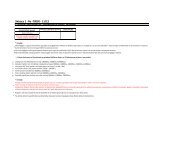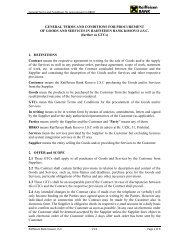Annual Report 2012 - Raiffeisen Bank Kosovo JSC
Annual Report 2012 - Raiffeisen Bank Kosovo JSC
Annual Report 2012 - Raiffeisen Bank Kosovo JSC
Create successful ePaper yourself
Turn your PDF publications into a flip-book with our unique Google optimized e-Paper software.
3.3.5. Investments at fair value through profit or loss<br />
An instrument is classified as at fair value through profit or loss if it is held for trading or is designated as such upon<br />
initial recognition. Financial instruments are designated at fair value through profit or loss if the Group manages such<br />
<br />
transaction costs are recognised in profit or loss when incurred. Financial instruments at fair value through profit or loss<br />
are measured at fair value, and changes therein are recognised in profit or loss.<br />
3.3.6. Offsetting financial instruments<br />
Financial assets and liabilities are offset and the net amount reported in the statement of comprehensive income when<br />
there is a legally enforceable right to offset the recognized amounts and there is an intention to settle on a net basis, or<br />
realize the asset and settle the liability simultaneously.<br />
3.3.7. Fair value measurement<br />
The determination of fair values of financial assets and financial liabilities is based on quoted market prices or dealer<br />
price quotations for financial instruments traded in active markets. For all other financial instruments fair value is<br />
determined by using valuation techniques. Valuation techniques include net present value techniques, the discounted<br />
cash flow method, comparison to similar instruments for which market observable prices exist, and valuation models.<br />
The <strong>Bank</strong> measures fair values using the following fair value hierarchy that reflects the significance of the inputs used in<br />
making the measurements:<br />
Level 1: Quoted market price (unadjusted) in an active market for an identical instrument.<br />
Level 2: Valuation techniques based on observable inputs, either directly (i.e., as prices) or indirectly (i.e., derived from<br />
prices). This category includes instruments valued using: quoted market prices in active markets for similar instruments;<br />
quoted prices for identical or similar instruments in markets that are considered less than active; or other valuation<br />
techniques where all significant inputs are directly or indirectly observable from market data.<br />
Level 3: Valuation techniques using significant unobservable inputs. This category includes all instruments where the<br />
valuation technique includes inputs not based on observable data and the unobservable inputs have a significant effect<br />
on the instrument's valuation. This category includes instruments that are valued based on quoted prices for similar<br />
instruments where significant unobservable adjustments or assumptions are required to reflect differences between the<br />
instruments.<br />
The <strong>Bank</strong> uses widely recognised valuation models for determining the fair value of common and simpler financial<br />
instruments. For these financial instruments, inputs into models are market observable. Valuation techniques include net<br />
present value and discounted cash flow models, comparison to similar instruments for which market observable prices<br />
exist and based on a current yield curve appropriate for the remaining term to maturity. The objective of valuation<br />
techniques is to arrive at a fair value determination that reflects the price of the financial instrument at the reporting date,<br />
which would have been determined by market participants acting at arm's length.<br />
The fair value of cash and cash equivalents, loan and advances to banks is approximately equal to the carrying value,<br />
because of their short-term maturity. The fair value of loans and advances to customers is approximately equal to their<br />
carrying value due to fact that the main part of the loan portfolio carries floating interest rates which reflect the changes<br />
in the market conditions.<br />
3.4. Derivative financial instruments<br />
Derivatives are initially recognized at fair value on the date on which a derivative contract is entered into and are<br />
subsequently measured at their fair value. Fair values are obtained from quoted market prices in active markets,<br />
including recent market transactions, and valuation techniques, including discounted cash flow models as appropriate.<br />
All derivatives are carried as assets when fair value is positive and as liabilities when fair value is negative. Gains and<br />
losses arising from changes in fair value of derivatives are included in ‘Gains and Losses from investment securities’ in<br />
profit or loss for the period.<br />
The <strong>Bank</strong> uses derivative financial instruments such as over the counter (OTC) interest rate options and forward currency<br />
contracts to hedge its risk arising from fluctuations of market interest rates and foreign currency fluctuations. No hedge<br />
accounting is applied for derivative instruments. Derivative financial instruments are initially recognized at fair value on<br />
the date on which the derivative contract is entered into and are subsequently measured at fair value and the change in<br />
fair values is recognized in profit or loss.<br />
37<br />
Addresses Glossary Financial Statements Segment <strong>Report</strong>s Overview Macroeconomic Environment RBI Vision and Mission Management Board Introduction

















